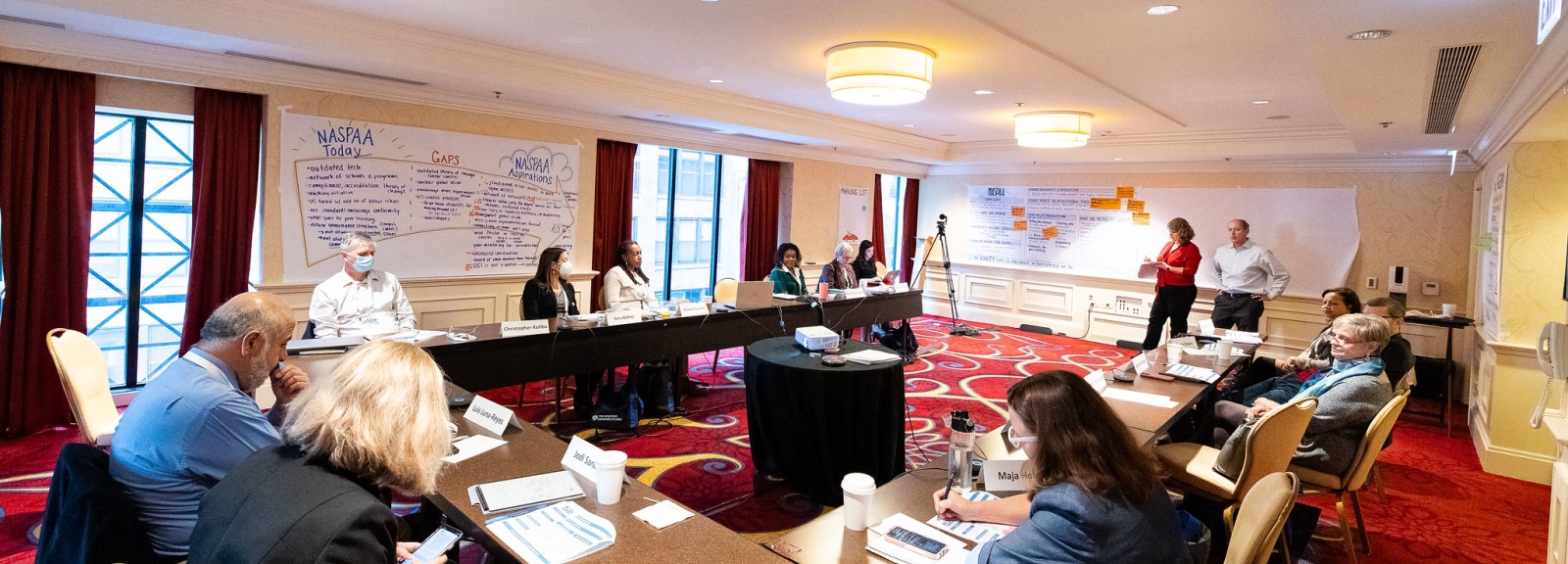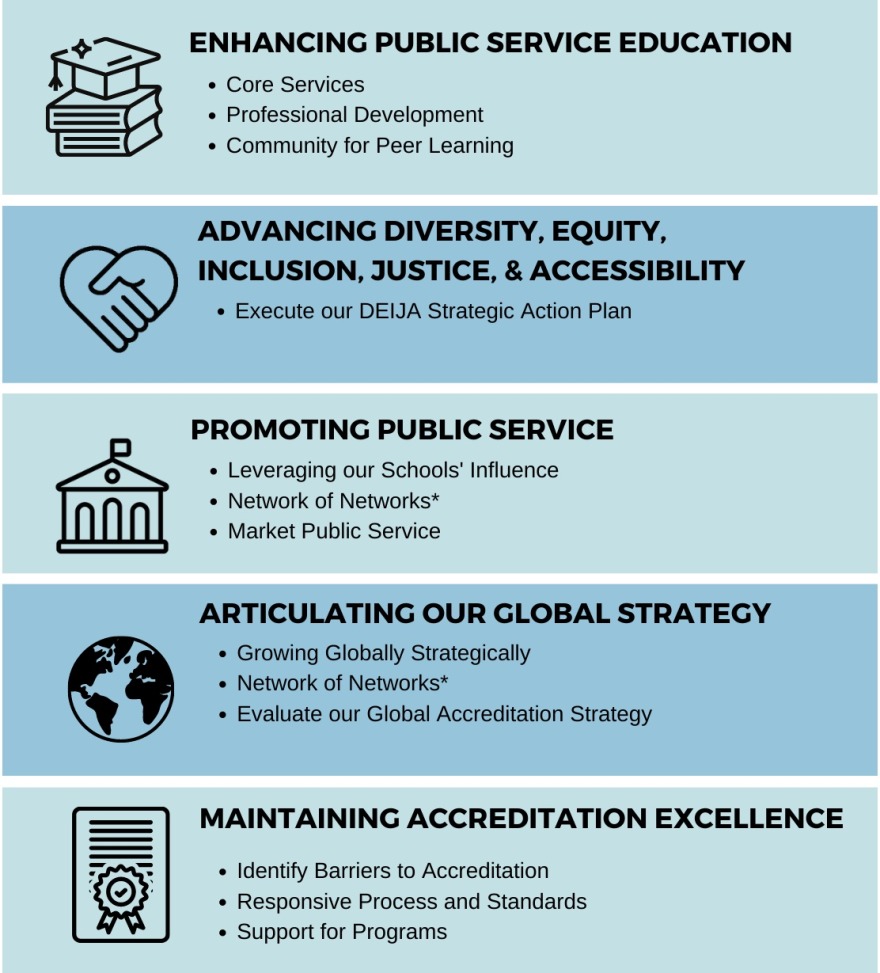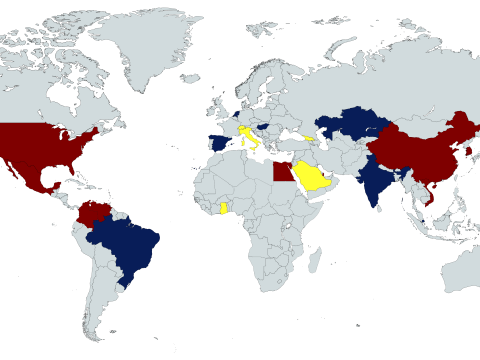
Strategic Plan
Strategic Planning Process
In March 2022, NASPAA staff convened a strategic planning committee to work with a consultant team on the strategic planning process. NASPAA engaged its membership and other stakeholder groups through a series of twelve focus groups, as well as a survey developed in partnership with WPR Consulting. NASPAA also engaged in conversations with peer organizations including the Volcker Alliance and the National Academy of Public Administration (NAPA) to identify opportunities for partnership.
At NASPAA’s Annual Conference in October, the Executive Council participated in a professionally facilitated strategic planning retreat. During the retreat, the Council reviewed stakeholder input and provided guidance on NASPAA’s priorities. Following the retreat, the strategic planning committee used feedback to develop this strategic plan, keeping the Executive Council apprised of the process and incorporating feedback.
Strategic Focus Areas & Objectives
NASPAA is highly valued for its role in enhancing public service education through programmatic efforts and member resources. We will continue to promote teaching excellence and strengthen the services we are most well-known for.
Objective 1.1: Core Services NASPAA will continue to strengthen its core services that advance public service education, including teaching & learning, the Annual Conference, data, and Pi Alpha Alpha. Our services will add value to members, helping them to strengthen public service teaching and training. NASPAA will also focus internally on systems improvement, innovative delivery, and sustaining a great culture – all of which will ultimately help us to provide excellence to our members.
Objective 1.2: Professional Development NASPAA will offer professional development opportunities for public service educators. We will enhance NASPAA NEXT and continue to develop opportunities for members at all levels in their careers.
Objective 1.3: Community for Peer Learning NASPAA will continue to strengthen its role as a community for peer learning. We will provide space for and promote conversations in various interest areas by supporting our committees, sections, and services such as the Admissions Directors Conference and the Career Professionals Conference.
Diversity, equity, inclusion, justice, and accessibility are at the core of NASPAA’s identity. We strive to go beyond simply viewing our work through an equity lens; we will be active champions for an inclusive public service education field.
Objective 2.1: Execute our DEIJA Strategic Action Plan NASPAA will implement steps identified in its DEIJA Strategic Action Plan, which has been developed in tandem with this overall strategic plan. This includes the following six key goals:
- Accreditation: Increase NASPAA accreditation at HBCUs and other underrepresented organizations associated with the organization domestically and internationally.
- Teaching and Learning: Serve as a resource and clearinghouse in support of the promotion and encouragement of NASPAA member institutions, staff, board members, and stakeholders to engage in the DEIJA work.
- Delivering Diversity in NASPAA and our Field: Develop and implement pipeline projects for NASPAA program activities, DEIJA recruitment assistance to member institutions, engagement opportunities for members, and heighten awareness of leadership and career opportunities within NASPAA for the purpose of improving DEIJA.
- Research and Recognition: Apply a DEIJA lens to all NASPAA awards, programs, and recognitions.
- Annual Conference Planning: Review all NASPAA future conference planning and practices with an eye toward amplifying diversity, access, equity, and inclusion.
- Communications and Internal Training: Conduct a NASPAA DEIJA organizational assessment to identify barriers, obstacles, and areas of improvement in organizational programs, policies, and practices, including internal training.
NASPAA will be a champion for public service professionals. We will use our collective power to advance public service and fight the rising trend of distrust in government.
Objective 3.1: Leveraging our Schools’ Influence NASPAA will develop a lobbying strategy and federal legislative agenda with a list of policy issues and funding requests to support our schools. We will leverage and mobilize our member schools’ advocacy networks to strengthen our collective influence.
Objective 3.2: Network of Networks[1] NASPAA will be a hub for other public service-related professional organizations. We recognize that we cannot achieve our goals alone. We will partner with peer organizations to develop strategic initiatives and advance the field as a whole.
Objective 3.3: Market Public Service NASPAA will promote the profession through marketing efforts and programmatic tools, including the continued development of the Champion Class. NASPAA strives for public service to be viewed as a desirable career field and academic path.
[1] Potential partner organizations include, but are not limited to: AAPAM, APPAM, ANZOG, CAPPA, EAPAA, ICMA, INPAE, NAPA, NISPAcee, the Partnership for Public Service, and the Volcker Alliance. This is a companion objective to 4.2, which focuses on global organizations and accreditors.
While NASPAA has historically been a U.S.-based organization, over the past decade, it has expanded its membership and accreditation efforts to include countries across the globe. We will continue to grow our membership and services globally while simultaneously working to define our global strategy.
Objective 4.1: Growing Globally Strategically NASPAA will determine our goals for growing global membership and services. We will identify what regions and countries of the world we want to be in and why we want to be there.
Objective 4.2: Network of Networks[1] NASPAA will continue to strengthen our existing relationships internationally even as we assess our global strategy. NASPAA will be a hub for other public service education-related professional organizations, including global accreditors. We recognize that we cannot achieve our goals alone. We will engage with peer organizations to develop strategic initiatives and advance the field as a whole.
Objective 4.3: Evaluate our Global Accreditation Strategy NASPAA will assess the past decade of Global Accreditation, determining what challenges we continue to face and what has worked.
[1] Potential partner organizations include, but are not limited to: AAPAM, APPAM, ANZOG, CAPPA, EAPAA, ICMA, INPAE, NAPA, NISPAcee, the Partnership for Public Service, and the Volcker Alliance. This is a companion objective to 3.2, which focuses on partnerships to promote the profession of public service.
Being a NASPAA-accredited program is a symbol of quality in the field of public service education. NASPAA consistently hears from our members that accreditation is important to them but at the same time the process of earning accreditation or reaccreditation can be burdensome. While we acknowledge that accreditation falls under COPRA’s purview, NASPAA will support a responsive approach to accreditation for qualified master’s programs.
Objective 5.1: Identify Barriers to Accreditation NASPAA will continuously evaluate barriers to accreditation and help to identify short-term approaches to reducing the burden on programs that do not diminish the quality of the standards.
Objective 5.2: Responsive Process and Standards NASPAA will work with COPRA to ensure accreditation standards continue to be a seal of excellence. Our accreditation process will be responsive to members’ needs; we want accredited members to go beyond compliance, encourage innovation, and feel pride in their status.
Objective 5.3: Support for Schools NASPAA will help facilitate accreditation processes that support the identified needs of accredited programs, as well as programs in the accreditation pipeline. Support services such as the Accreditation Institute and site visitor training will be strengthened and developed, taking into account the diversity of our programs, including size, HBCU/MSI status, and other contexts.
Download Strategic Plan
Implementation Plan
The work plan for implementing this strategic plan will be developed by NASPAA staff with support from the Executive Council. Key activities under each focus area and objectives will be identified on at least an annual basis. Indicators of success will be used to track progress and support shared accountability across the organization regarding progress on the various priorities.
Deeper Dive
NASPAA debuted its strategic plan in February 2023. As we implement the strategic plan, there will be a deeper look into each of the focus areas below.




